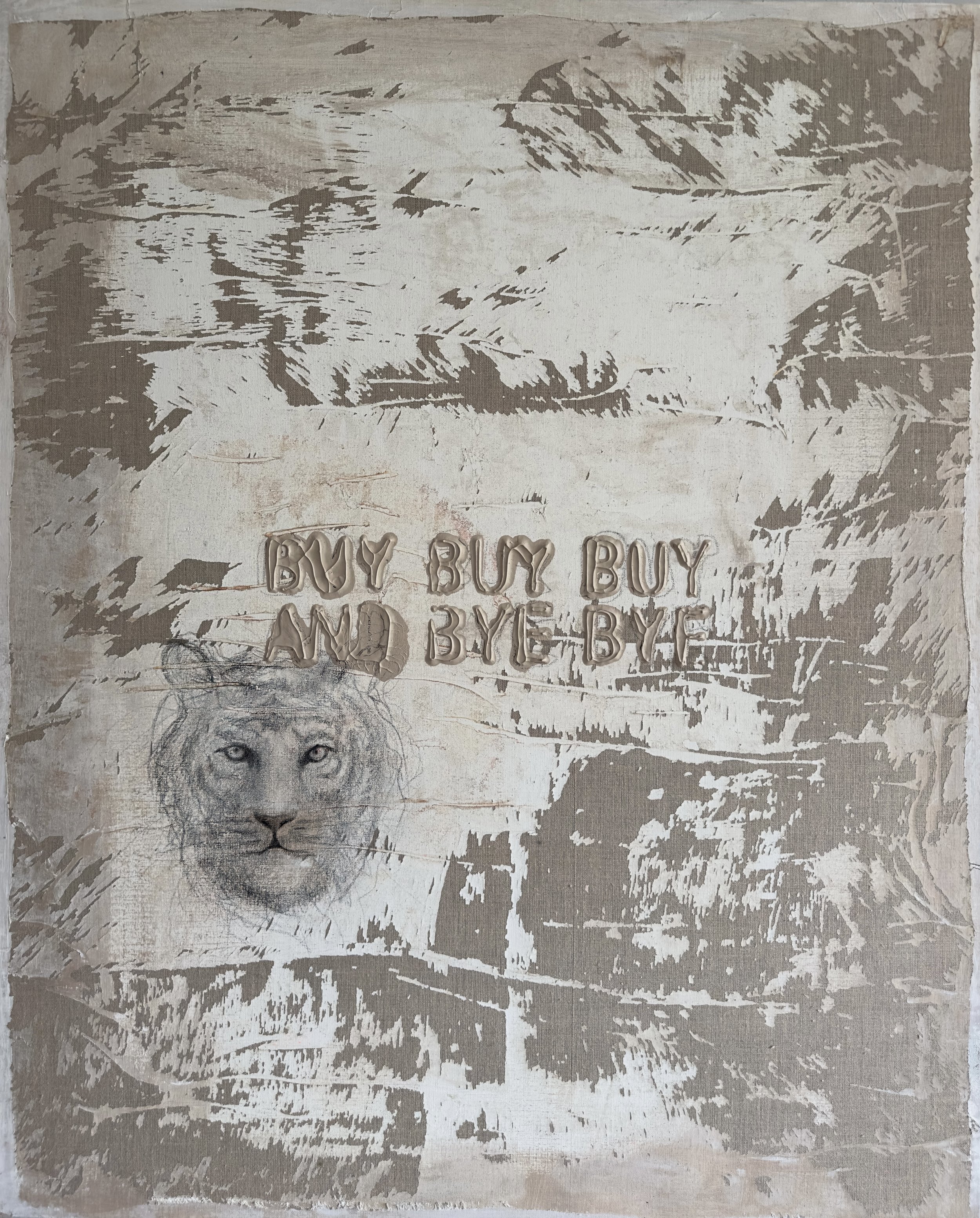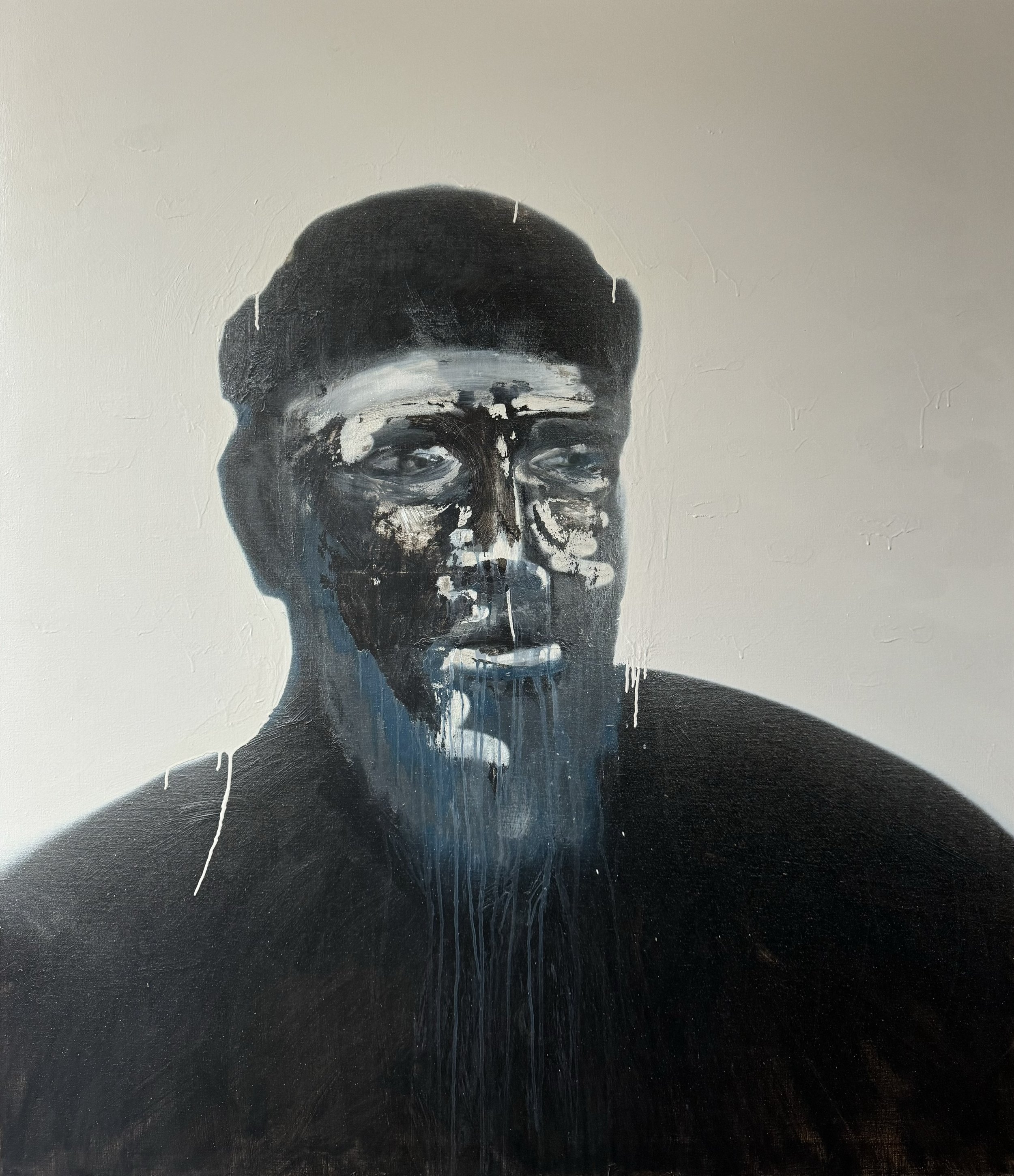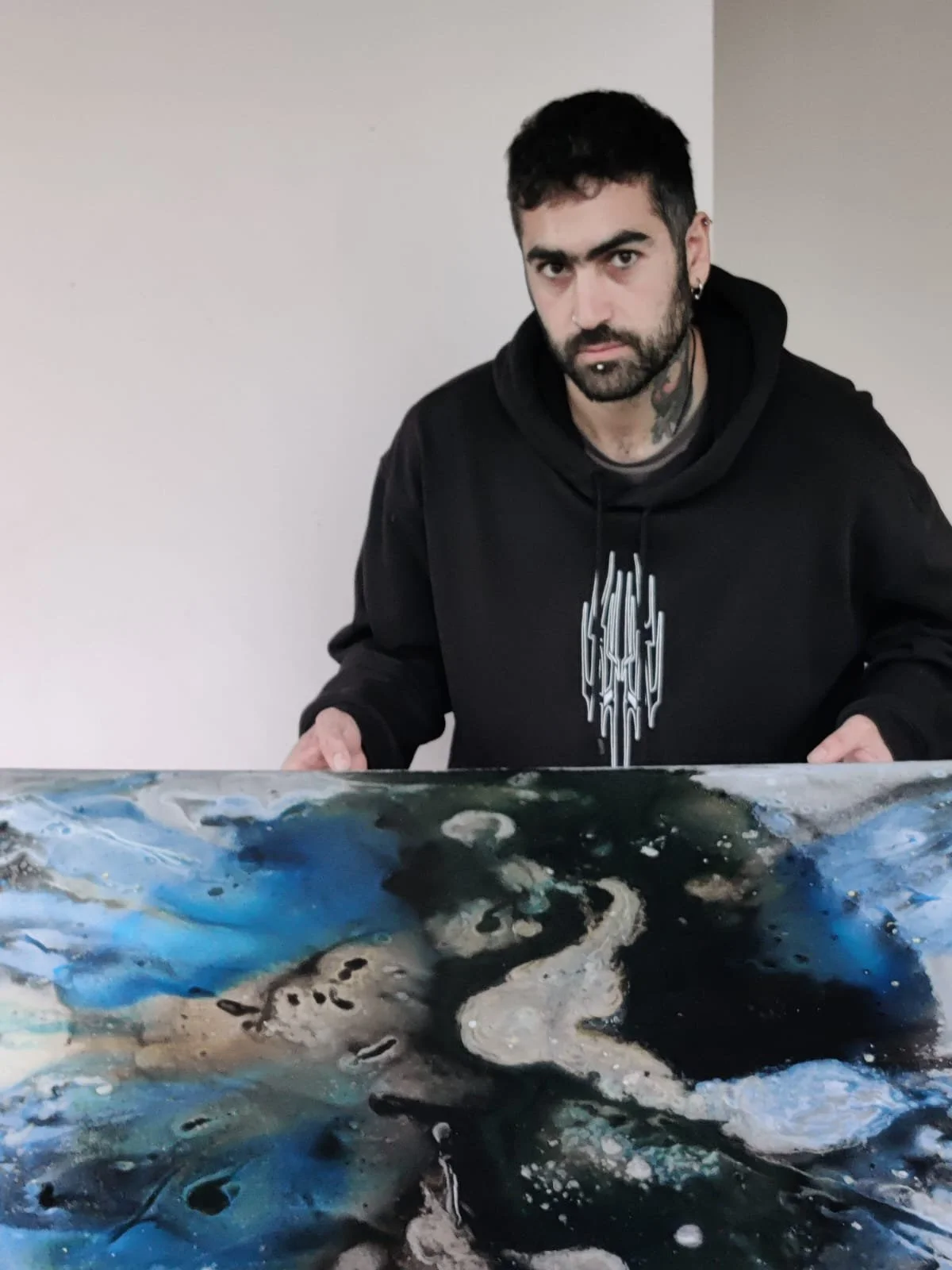10 Questions with Misha Waks
Al-Tiba9 Art Magazine ISSUE15 | Featured Artist
For 15 years, Misha Waks worked for various corporations as a designer. In 2019, he started creating art that allows him to draw attention to things really important. Misha Waks refers to themes related to ecology, women's rights, and minorities. He is inspired by current events, news, and images from the internet, press, and television. He explores topics related to the concepts of post-nature and the Anthropocene. He is interested in humans, their relationship with nature and other people. He uses various means of expression; among the most important are painting, sculpture, installations, performance, and video. Misha Waks lives and works in Warsaw.
Misha Waks - Portrait
“Art is a form of activism.”
Sustain, Acrylic on canvas, 57x57 cm, 2022 © Misha Waks
AL-TIBA9 ART MAGAZINE ORIGINAL ISSUE15
INTERVIEW
Please tell us a bit about yourself. How did you become interested in art and develop into the artist you are today?
I have been interested in art for as long as I can remember. I have always created something. Even during my studies, I spent more time in drawing or painting studios than in design studios. Throughout my studies, I wrote down ideas for various conceptual works. I had hundreds of them, and none of those I realized. For a while, I didn't wonder if this notebook of ideas was an interesting work in itself. I need to find it.
BUY BYE…Tiger, Acrylic on canvas, 100x80 cm, 2022 © Misha Waks
Twilight, Acrylic on canvas, 100x80 cm, 2021 © Misha Waks
Can you share with us how your transition from working in corporations as a designer to becoming an artist came about? And how has your background in design influenced your approach to creating art that serves as a form of activism?
I actually went to study design out of common sense. My parents threatened me with a lack of support if I chose a direction other than design, so I barely agreed to go to art school. Teachers at that time advised me to go to design: "You will have a trade-in your hands, and if you want, you can always paint.” In fact, I didn't really know what it entailed, and I still got the second place after practical classes. I was first but messed up art history, so in the end, I got second place. I graduated with honors because if I do something, I always put a lot of heart and work into it. My diploma was rated as the best in Poland by 2+3D magazine. Design comes easily to me, and I've had a lot of success in this field; however, over the years, I've been missing something all the time. Maybe the fact that I realized more and more that I was designing things that, in fact, are not needed by anyone for anything; they are just another creation produced so that the factory can sell something. In addition, all these fashions, the fact that today we sell the color blue and another black, or round things, or simpler shapes, what sense does it actually make and how much havoc we do by such action on the planet? ln addition, another aspect of the work was to support the sale of things whose ideas are personally alien to me. This disconnect made me feel less and less like doing it. I didn't see the point in it. Working for many years for corporations (I had my own company which served corporate clients), I developed such an aversion to the next campaign or product because I knew that all this work ends up in the trash anyway, items go out of fashion, the product cycle ends, and it has to be replaced by another one, and so on and so forth. By creating art, I wanted to give my work meaning. Art itself, as I perceive it, by definition, may be devoid of such meaning, but for me, if it contains elements of activism, e.g., raises a subject important to me and changes its perspective, it is all the more valuable. Creation is not a linear process. Also, such an assumption is difficult. to realize because art itself involves an element of the unexpected in that it differs from design. Often, I have no control over what I do; I don't plan to realize one work or another. Such an activity would remind me too much of the design process. For me, art is a form of experimentation with both form and content. I go to the studio, and I don't know what I'm going to do on a given day. This lack of predictability is most interesting to me. It's a constant search, and it's a risk. I often think about my creative process, that I have to break something first so that something new can be created. Also, I am not afraid to destroy my works to discover new ones. How does activism relate to this? Any creative activity that touches on something important to the artist is a form of activism. Activists act in ways appropriate to the problems they are trying to solve or publicize. The artist, on the other hand, acts within the means he uses, which is why I believe that art is a form of activism. It addresses topics that are important to the artist in question. For me, these are women's or minority rights, climate change, and important current events.
Healthy plants, Acrylic on canvas, 150x130 cm, 2022 © Misha Waks
You use various means of expression, such as painting, sculpture, installations, performance, and video. How do you decide which medium best serves the message you want to communicate? Could you walk us through your creative process when tackling your key themes? How do you translate these concepts into tangible artworks?
When I decided to enter the world of art, I stated that I would not limit myself in any way. The world of design has its rules; the world of art is, for me, this oasis of freedom where I want to realize my visions. I don't stick to forms or chewed techniques. Sometimes, I have a specific idea related to a subject that interests me. Other times, the work is created in the process. What I care about is that the subject I am addressing finds a medium that best represents it as a subjective assessment, and sometimes I make it consciously, other times completely spontaneously, as, for example, in the case of the work "The Last Man on Earth." One day, I imagined the footprint of the last man walking the earth. At the time, I was doing work related to another topic, acrylic and flour. Suddenly, I chewed the mass on the ground, trampled it, and imprinted the footprint of my shoes. I added a white flag made from a T-shirt I was wearing at the time as a sign of surrender, and that's how this work was created. Then I realized that it was the reverse of the photo of the first man on the moon. On the one hand, we conquer other planets and leave ours destroyed. Our egos lead us to great discoveries but also to downfall. In the end, we must surrender in the fight against our egos. Then, maybe we will achieve peace and leave our planet alone. This theme runs through my subsequent works.
Your work explores topics related to the concepts of post-nature and the Anthropocene. How do these themes manifest in your artistic practice, and what message are you hoping to convey through them?
There is no place on earth that has not been scarred by human presence. Microplastics can be found everywhere. In my latest series of works, I return to that moment when the last piece of land was discovered contaminated at the same time. I try to find our human motivations, and again, I come across our egos. It was our egos that pushed us to the South Pole, where, in several expeditions, people lost their lives to get it and finally succeeded. By visually recreating the expeditions, I try to find elements that are the same for the world of animals, people, and nature. For what was then and what is today. It is clear that nothing has changed. As humans, we behave exactly the same way we did 100 years ago, but I wonder if the influence of technology today is changing our perception of the world so that we begin to do things we once would not do. Man in the age of the Anthropocene seems to have evolved into a whole new entity on the borderline of collective and personal consciousness, living on the border of two worlds in complete contrast to how it used to be. This contact is of great interest to me.
It's Hard, Acrylic on canvas, 100x80 cm, 2022 © Misha Waks
Selfportrait, Acrylic on canvas, 2024 © Misha Waks
Could you walk us through your creative process when tackling your key themes? How do you translate these concepts into tangible artworks?
One of the most interesting I can describe is the process of creating works related to a theme in some specific way for a given period of time. I don't think about it; I just create until I see what emerges from a given series of what it's really about. This detachment, not judging at the initial stages, gives more openness to what may come in the future. I create in such a cycle of 100 or 200 works, and as we see them separately, they do not tell us much. Only the whole can discover new content. Such a method is close to the works created on paper for me, where I often, without thinking, realize a whole series of works in which I later discover the content.
Your artist statement succinctly states, "Art is a form of activism." How do you see your art contributing to social change and raising awareness about pressing issues?
I don't expect my works to change anything, but perhaps they are such a brick that I can add from myself to the changes I would like our society to shape. It's nice to see people who are detached from their own affairs at the vernissage talk about the problems of this world. It's not much, but something can always be the beginning of change. I want to believe in that. In addition to taking on activism-related topics, I try to make my work sustainable. I use old newspapers or water-based techniques to produce my works.
Soot, 2022 © Misha Waks
As an artist who draws inspiration from current events and media sources, how do you balance personal expression and addressing societal concerns in your artwork?
It's hard to predict, but if I think a lot about a subject and get to work, then, in my case, what I think about is reflected in the final work. I create my own language, which is created sometimes without thinking and without any specific assumptions mechanically. Still, because it is my language, I begin to read from the works that I have created, like from a book. Sometimes, I created works under the influence of some information, for example, a series of works about the burning forests, the war in Ukraine, or the situation on the Polish border; these were the works realized spot-on under the influence of emotions related to these events. In such works, I don't make a direct reference to what is happening but try to understand the phenomenon of these events and present it in a universal way that is somehow detached from time and place.
What challenges do you face when addressing sensitive topics such as ecology, women's rights, and minorities in your art, and how do you approach overcoming them?
I have the impression that, on the one hand, there is such a thing as freedom of expression. On the other hand, there is a certain hidden censorship in the market. The fact that by creating works that are sometimes controversial, you expose yourself to the ostracism of some group is one thing. Still, the other thing is that participants in the art market, such as galleries, etc., want to sell or show work to the general public. I try to express myself on topics that may divide communities in a descriptive way, i.e., one that shows reality as seen through my eyes. I do not want my work to be a cause for agitation. They can be used to reflect on the condition of certain phenomena. For me, art is a form of activism, and if we want to continue to see it as art, I think that it cannot be pure activism, journalism, or agitation. It must be open to interpretation and accessible to a wide audience.
We Are Waiting, 2024 © Misha Waks
Are there any particular future projects or themes you are currently exploring or planning to explore in your work? If so, please give us a glimpse into what we can expect.
One of these themes is related to the discovery of the South Pole as a concept of the "Last Place on Earth." This is a series of works that go back to the time of the first expeditions to this corner of the earth that I mentioned before. At the same time, I am working on works that relate to current topics but are somehow mysteriously connected to my upbringing and the aesthetics in which I grew up. This is a series of large spray and acrylic paintings.
And lastly, how do you envision the role of art evolving in activism and social change movements in the future, and where do you see your own practice fitting into this trajectory?
More and more things require grassroots efforts. People are more aware today; hence, I believe that art that uplifts such trends will be increasingly recognized and appreciated. There is more and more talk about eco-terrorism as a phenomenon that will play a greater role in the times to come. It is related to the lack of connectivity and understanding, the frustration of entire generations of people already condemned to live under both climatic but also social and political conditions that are unacceptable to these groups. Art that reflects these sentiments and is nothing less than a record of a historical moment I think will grow in popularity. Of course, at the end of the day, it all comes down to the question of whether it will be good art.



























